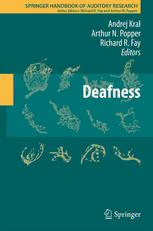
Deafness PDF
Preview Deafness
SPRINGER HANDBOOK OF AUDITORY RESEARCH Series Editors: Richard R. Fay and Arthur N. Popper Andrej Kral Arthur N. Popper Richard R. Fay Editors Deafness Springer Handbook of Auditory Research For furthervolumes: http://www.springer.com/series/2506 Andrej Kral (cid:129) Arthur N. Popper Richard R. Fay Editors Deafness With 54 Illustrations Editors AndrejKral ArthurN.Popper InstituteofAudioneurotechnology DepartmentofBiology HannoverMedicalSchool UniversityofMaryland D-30625Hannover,Germany CollegePark,MD20742,USA RichardR.Fay MarineBiologicalLaboratory WoodsHole,MA,USA ISSN0947-2657 ISSN2197-1897(electronic) ISBN978-1-4614-7839-3 ISBN978-1-4614-7840-9(eBook) DOI10.1007/978-1-4614-7840-9 SpringerNewYorkHeidelbergDordrechtLondon LibraryofCongressControlNumber:2013944528 ©SpringerScience+BusinessMediaNewYork2013 Thisworkissubjecttocopyright.AllrightsarereservedbythePublisher,whetherthewholeorpart of the material is concerned, specifically the rights of translation, reprinting, reuse of illustrations, recitation,broadcasting,reproductiononmicrofilmsorinanyotherphysicalway,andtransmissionor informationstorageandretrieval,electronicadaptation,computersoftware,orbysimilarordissimilar methodologynowknownorhereafterdeveloped.Exemptedfromthislegalreservationarebriefexcerpts inconnectionwithreviewsorscholarlyanalysisormaterialsuppliedspecificallyforthepurposeofbeing enteredandexecutedonacomputersystem,forexclusiveusebythepurchaserofthework.Duplication ofthispublicationorpartsthereofispermittedonlyundertheprovisionsoftheCopyrightLawofthe Publisher’s location, in its current version, and permission for use must always be obtained from Springer.PermissionsforusemaybeobtainedthroughRightsLinkattheCopyrightClearanceCenter. ViolationsareliabletoprosecutionundertherespectiveCopyrightLaw. The use of general descriptive names, registered names, trademarks, service marks, etc. in this publicationdoesnotimply,evenintheabsenceofaspecificstatement,thatsuchnamesareexempt fromtherelevantprotectivelawsandregulationsandthereforefreeforgeneraluse. While the advice and information in this book are believed to be true and accurate at the date of publication,neithertheauthorsnortheeditorsnorthepublishercanacceptanylegalresponsibilityfor anyerrorsoromissionsthatmaybemade.Thepublishermakesnowarranty,expressorimplied,with respecttothematerialcontainedherein. Printedonacid-freepaper SpringerispartofSpringerScience+BusinessMedia(www.springer.com) This volume is dedicated to Rainer Klinke (1936–2008), Professor of Neurophysiology at J. W. Goethe University in Frankfurt am Main (1977–2004), in appreciation of his contributions to auditory neuroscience, his mentorship, his support for deafness research, and his efforts in education of medical students. His curiosity on all aspects of nature remains a constant inspiration to his friends and former colleagues. Series Preface The following preface is the one that we published in Volume 1 of the Springer Handbook of Auditory Research back in 1992. As anyone reading the original preface,orthemanyusersoftheseries,willnote,wehavefarexceededouroriginal expectationofeightvolumes.Indeed,withbookspublishedtodateandthoseinthe pipeline,wearenowsetformorethan50volumesinSHAR,andwearestillopen tonewandexcitingideasforadditionalbooks. Weareveryproudthatthereseemstobeconsensus,atleastamongourfriends and colleagues, that SHAR has become an important and influential part of the auditoryliterature. Whilewehaveworkedhardtodevelopandmaintainthequality and value of SHAR, the real value of the books is very much because of the numerous authors who have given their time to write outstanding chapters and to ourmanycoeditorswhohaveprovidedtheintellectualleadershiptotheindividual volumes.Wehaveworkedwitharemarkableandwonderfulgroupofpeople,many of whom have become great personal friends of both of us. We also continue to work with a spectacular group of editors at Springer, currently Ann Avouris. Indeed, several of our past editors have moved on in the publishing world to become senior executives. To our delight, this includes the current president of SpringerUS,Dr.WilliamCurtis. But the truth is that the series would and could not be possible without the support of our families, and we want to take this opportunity to dedicate all of the SHAR books, past and future, to them. Our wives, Catherine Fay and Helen Popper, and our children, Michelle Popper Levit, Melissa Popper Levinsohn, Christian Fay, and Amanda Fay, have been immensely patient as we developed andworkedonthisseries. Wethankthem,andstate,withoutdoubt,thatthisseries couldnothavehappenedwithoutthem.WealsodedicatethefutureofSHARtoour nextgenerationof(potential)auditoryresearchers—ourgrandchildren—Ethan and SophieLevinsohn;EmmaLevit;andNathaniel,Evan,andStellaFay. vii viii SeriesPreface Preface 1992 The Springer Handbook ofAuditory Research presents aseries of comprehensive and synthetic reviews of the fundamental topics in modern auditory research. Thevolumesareaimedatallindividualswithinterestsinhearingresearchinclud- ingadvancedgraduatestudents,postdoctoralresearchers,andclinicalinvestigators. The volumes are intended to introduce new investigators to important aspects of hearing science and to help established investigators to better understand the fundamental theories and data in fields of hearing that they may not normally followclosely. Each volumepresentsaparticulartopic comprehensively,andeach serves asa syntheticoverviewandguidetotheliterature.Assuch,thechapterspresentneither exhaustive data reviews nor original research that has not yet appeared in peer- reviewed journals. The volumes focus on topics that have developed a solid data and conceptual foundation rather than on those for which a literature is only beginningtodevelop.Newresearchareaswillbecoveredonatimelybasisinthe seriesastheybegintomature. Each volume intheseries consistsofafewsubstantialchaptersonaparticular topic.Insomecases,thetopicswillbeonesoftraditionalinterestforwhichthereis asubstantialbodyofdataandtheory,suchasauditoryneuroanatomy(Vol.1)and neurophysiology (Vol. 2). Other volumes in the series deal with topics that have beguntomaturemorerecently,suchasdevelopment,plasticity,andcomputational models of neural processing. In many cases, the series editors are joined by a coeditorhavingspecialexpertiseinthetopicofthevolume. RichardR.Fay,Falmouth,MA ArthurN.Popper,CollegePark,MD Volume Preface This book considers deafness as a medical condition, exploring the neuronal consequences on the peripheral and the central nervous system, as well as on cognition and learning, viewed from the standpoint of genetics, neuroanatomy and neurophysiology, molecular biology, systems neuroscience, and cognitive neuroscience. The chapter by Zippora Brownstein, Shaked Shivatzki, and Karen Avraham reviewsthecomplexityofthe genetic backgroundofhearing loss, showing thatit can result from molecular changes at various levels of the auditory system. Next, the chapter by Patricia Leake, Olga Stakhovskaya,and Stephen Rebscherreviews histopathologicalconsequencesofdeafnessonthecochleaandthespiralganglion inhumansandinanimalmodels. The chapter by Michael Muniak, Catherine Connelly, Natasha Tirko, Jahn O’Neil, and David Ryugo reviews the animal models used in deafness research and discusses their advantages and disadvantages with respect to human deafness and therapy with cochlear implants. Following this, Dan Sanes focuses on func- tional consequences of deafness on individual neurons throughout the auditory pathway and reviews the evidence on the effects of deafness on excitation and inhibition at several levels of the auditory system. The chapter by Andrej Kral, Peter Baumhoff, and Robert Shepherd focuses on integrative function of the auditory pathway in deafness by analyzing feature sensitivity in the auditory system, both in the spectral as well as in the temporal domain, and discusses the consequences of deficits for categorization of auditory inputs. This is complementedbythechapterbyAnuSharmaandTeresaMitchell,whichconsiders the human auditory system and developmental effects of deafness and cochlear implantation.Followingthis,DianeLazard,Anne-LiseGiraud,andPascalBarone furtherextendthediscussiononmultisensoryintegrationindeafnessbyreviewing ix
